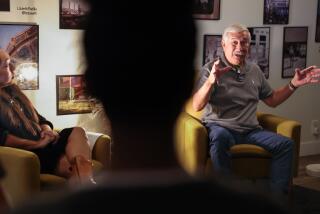Eastside memories
- Share via
“The Eastside Boys” (by Erin J. Aubry, July 20) found a warm spot in my heart. In 1954, we moved from a small town in Alabama to 65th and San Pedro, where my brother attended 66th Street School. Shortly afterward, we moved to Boyle Heights, where most of our growing up occurred. We visited the Eastside often, because that was where most of our relatives and family friends lived.
During World War II, even though I was young, I remember an L.A. that was much different. The Eastside’s black community was a lot friendlier, more compassionate and more goal-oriented than it has been since. Most of all, I remember the family feeling you experienced when you visited others, even if they were not relatives. As Billy Benfield put it, “We didn’t realize what we had at the time, so we didn’t know what we would miss.”
Samuel Carter
Ventura
*
A few years back, I wanted to tell the Eastside story from a different perspective. I wanted the world to know what it was like growing up “Negro,” “Mexican” and “Oriental” (World War II terms) in ‘40s and ‘50s Los Angeles. In our diverse and amicable world, there were no homicidal street gangs and homeboy killings. Crack cocaine did not exist, and crass graffiti, panhandlers and child- molesters were hardly in evidence. It was even OK to be black and female on the Eastside, because the streets were largely safe and sane.
But enthusiasm for my project was stifled recently when I drove down Central Avenue from Slauson to Washington Boulevard. What was once a bustling neighborhood of cafes, movie houses, apparel shops and mom-and-pop grocery stores had become overcrowded, metal-grated storefront living quarters for disenfranchised immigrants. I could not reconcile the “then” portrait in my mind with the “now” image of reality, and it became all too clear that it’s hard to go home again.
Jeanne A. Taylor
Los Angeles
*
I was born on the Eastside, and the wealth I gained from growing up there has enriched the lives of my family and my friends. The Eastside was the beginning of my destiny, not the end of the line, and the value I gained from it seems universal and eternal.
Because of efforts like Aubry’s, perhaps we will appreciate what we do have and maybe even reconstruct our present communities into thriving places similar to what we had on the Eastside.
Jacqueline Saracino
Canoga Park
*
You must know where you come from to appreciate where you are now. Aubry, through her writing, has triggered memories that enable us to appreciate our origins, where we’ve journeyed and the fact that we continue to grow. She noted that while we were looking for greener pastures, the promised land was right there on Central Avenue. Most of the time, we do have it all--right where we happen to be.
Carol Tucker
Los Angeles
*
The author states that Hal Miller was “one of a handful of black students” who tried to integrate Fremont High School in the late ‘40s. What the story doesn’t say is what happened next. With the arrival of black students, hundreds of other students walked out and attempted to close the school--and did so with the support of their parents.
Val Rodriguez
Signal Hill
More to Read
Sign up for Essential California
The most important California stories and recommendations in your inbox every morning.
You may occasionally receive promotional content from the Los Angeles Times.













